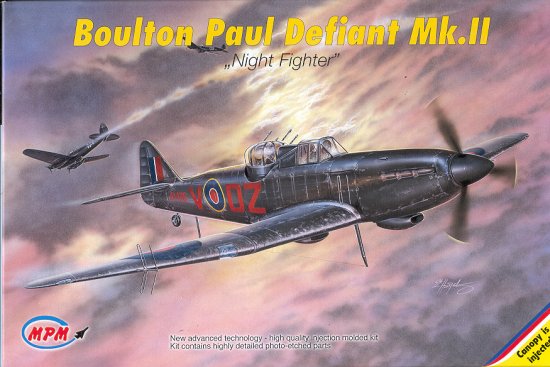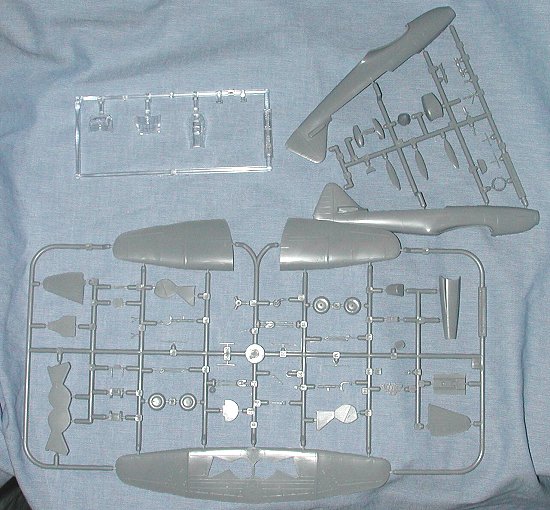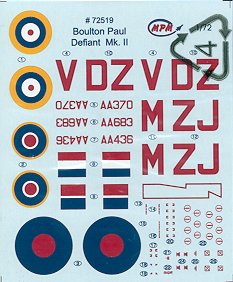
|
KIT: |
MPM 1/72 Defiant II |
|
KIT # |
72519 |
|
PRICE: |
£ |
|
DECALS: |
Three aircraft |
|
REVIEWER: |
|
|
NOTES: |

|
HISTORY |
Eagerly embracing this radical idea, the British went into production with the Defiant for the RAF and the Roc for the Fleet Air Arm. To say that the plane was not quite up to specs would be putting it mildly. The first time Defiants were attacked from the rear, the four-gun turret was a rather nasty surprise. However, once the cat was out of the bag, Luftwaffe fighters made short work of the hapless Defiant. You see, having the turret added weight. Adding an extra crewman added weight. Having the turret in the air stream added drag. Adding the turret required a bigger airframe. All of this equaled a plane that was slower than the Hurricane (which used the same engine), and unable to properly dogfight with the more nimble Luftwaffe fighters. They were also unable to get to the enemy bomber streams where the four gun turret would be an advantage.
The type was quickly withdrawn
from the day fighter role. Being stuck with all these airframes wasn't
good. Fortunately, one didn't need to be particularly fast or nimble to
be a night fighter. In fact, the turret could be a real benefit against
slow bombers, where the Defiant had some small success. When Air
Intercept (AI) radar was available in 1941, a number of Defiants had this
equipment installed. This vastly improved the success of the aircraft and
by the end of the year, the Defiant was the most successful British night
fighter in the arsenal.
|
THE KIT |

Once more, a much more modern MPM kit. This one has no resin, no vac canopies and only a smattering of photo etch; that for the radar aerials. Naturally, I'm pretty happy about this improvement as while resin and PE are nice, it is also nice not to have to do the extra work and have to use superglue, which these more exotic materials require.
The kit itself is nicely molded with crisply done panel lines. I found no problems with flash, or ejector pin marks. The only sink mark I found was on the radiator insert. MPM is still doing separate prop blades and molding its wheels in two flat halves. Perhaps correcting these will be the next step.
The cockpit has detail on the sidewalls and a selection of radio boxes and quadrants to add to it. A nice touch is a photo of the real cockpit for some guidance. There are also photos of the landing gear and gear doors, undoubtedly photographed at the RAF Museum. The turret assembly appears complicated enough to be believable. The turret itself is in two parts, which will make for getting rid of the seam a bit of a chore. It seems to me that molding technology is advanced enough for this to be done as a single piece, for it sure would be a help.
The turret does not seem to be designed to rotate, and in any case has to
be aimed to the rear as there is no option to lower the rear deck to
provide room for the turret to rotate as is shown on the box art. Nor is
there an optional canopy which also has a section that would be lowered
during this time. The clear parts are very clear and superbly formed. There
is no option for an opening canopy, so those who want to show off their
interior work will have to break out the razor saw or vac a new sliding
section. To use the clear landing lights, the area on the wing leading edge
has to be cu t out prior to
installation. Probably the most difficult part of construction is the
installation of all the little metal AI antennas. No guide on the parts is
given for their placement so one has to carefully read the instructions to
guesstimate their location on the airframe. Those who are really not ready
for putting on these bits can model a version prior to the installation of
the AI radar. Check for references.
t out prior to
installation. Probably the most difficult part of construction is the
installation of all the little metal AI antennas. No guide on the parts is
given for their placement so one has to carefully read the instructions to
guesstimate their location on the airframe. Those who are really not ready
for putting on these bits can model a version prior to the installation of
the AI radar. Check for references.
Instructions are excellent as mentioned, with alignment guides and photos to help with construction. All the Humbrol paint numbers have names with them for those of us not using Humbrol paints. You can do this kit in any color as long as it is black. Markings are for three planes. One is the box art aircraft of 151 sq in 1941, followed by one from an unknown unit as well as the prototype night fighter with the AI radar. Decals are the usual excellent ones and a full set of stencils is provided as well, for those who have the patience. It will be interesting to see if the red decals disappear against the black background. MPM decals are usually very opaque so shouldn't provide any problems in this area.
|
CONCLUSIONS |
Well, chalk up one more ancient Airfix kit to the trash bin or the sale table. No need to spend all the time correcting that old dinosaur now that MPM has provided a modern replacement. It is good to see the lack of resin and the minimal use of etched metal. This makes the model much more mainstream.
If you would like your product reviewed fairly and quickly by a site that has over 200,000 visitors a month, please contact me or see other details in the Note to Contributors.